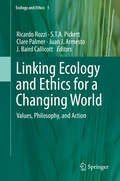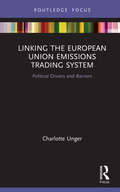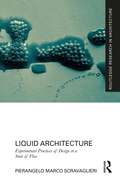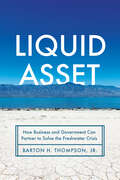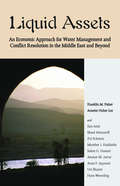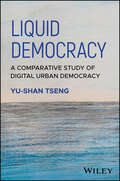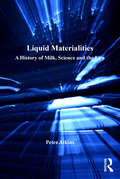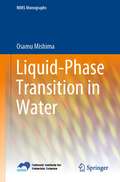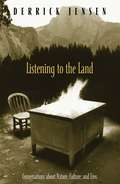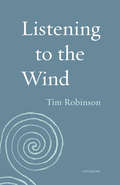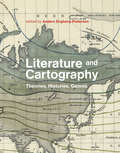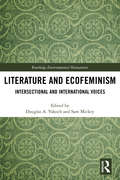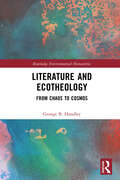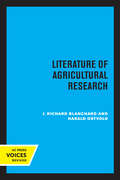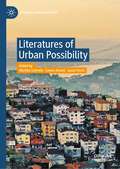- Table View
- List View
Linking Ecology and Ethics for a Changing World
by J. Baird Callicott Clare Palmer Ricardo Rozzi S. T. A. Pickett Juan J. ArmestoTo comprehensively address the complexities of current socio-ecological problems involved in global environmental change, it is indispiseble to achieve an integration of ecological understanding and ethical values. Contemporary science proposes an inclusive ecosystem concept that recognizes humans as components. Contemporary environmental ethics includes eco-social justice and the realization that as important as biodiversity is cultural diversity, inter-cultural, inter-institutional, and international collaboration requiring a novel approach known as biocultural conservation. Right action in confronting the challenges of the 21st century requires science and ethics to be seamlessly integrated. This book resulted from the 14th Cary Conference that brought together leading scholars and practitioners in ecology and environmental philosophy to discuss core terminologies, methods, questions, and practical frameworks for long-term socio-ecological research, education, and decision making.
Linking Local and Global Sustainability
by Howard Harris Stephen Mckenzie Sukhbir SandhuThe book takes a holistic approach to sustainability. Acknowledging the Brundtland definition, that sustainable development meets the needs of the present without compromising the ability of future generations to meet their own needs, the book is specifically concerned with the ethics of contemporary social and environmental sustainability activity and thinking. It is concerned with the role of institutions-both local and global in achieving sustainability initiatives. All twelve chapters extend sustainability-conceptually, empirically and theoretically, and in doing so provide insights into linking local and global sustainability. The book refocuses sustainability as a series of interwoven and dynamic relationships, backed by just ethical decision-making, which begin locally, and reach out to impact the global level.
Linking Networks: The Formation Of Common Standards And Visions For Infrastructure Development (Transport And Society Ser.)
by Hans-Liudger DienelPresenting recent research on the international integration of infrastructures in Europe, this book combines general and methodological chapters and examples from different a variety of sectors such as transport, electricity and communication networks. Particular focus is on the contrast between the 'Europe of nation states' of the nineteenth century (up to 1914) and the emerging 'integrated Europe' after World War II. Additional contributions provide perspectives from beyond Europe. The wide range of topics gives a good overview of the different challenges posed and the strategies employed in each sector to establish internationally compatible networks, procedures and standards. This work strengthens comparative research as a complement to the detailed analysis of singular cases that often characterises previous works in this field. Methodologically, it therefore contributes to the progress of tools and strategies for comparative historical research. Part of the emerging research area dealing with the mechanisms of international collaboration, this book brings together recent research from European integration history, policy studies, political economy and cultural studies. Considering the growing intensity of international collaboration and exchange in many parts of social and economic life, it is also of topical interest.
Linking the European Union Emissions Trading System: Political Drivers and Barriers (Routledge Focus on Environment and Sustainability)
by Charlotte UngerThis book focuses on the linking of the European Union Emissions Trading System (EU ETS) with other independent regional ETS. While rich practical and academic research has evolved on the economic and technical side of ETS linking, political drivers and barriers have so far been underrepresented in this debate. Filling this lacuna and based on international relations theory, existing research and qualitative fieldwork, this book introduces the range of political conditions that influence linking, such as political leadership and stakeholder activity. Specifically, it analyzes which of these aspects have played a role in three different linking activities of the EU: (1) a failed linking attempt: EU ETS–California Cap-and-Trade Program; (2) a successful linking treaty: EU ETS–Switzerland Emissions Trading System; and (3) an agreed-upon but not realized link: EU ETS–Australia Carbon Pricing Mechanism. Through an interrogation of these examples, Dr. Unger concludes that it is not only the technical challenges or the overall economic benefit but rather domestic interests, structural aspects, and external international political developments that have jointly dominated linking activities, especially those in which the EU takes part. This book will be of great interest to scholars and policy-makers working in climate policy and EU environmental politics.
Lions and Tigers and Hamsters: What Animals Large and Small Taught Me About Life, Love, and Humanity
by Dr. Mark GoldsteinFrom the time Dr. Mark Goldstein was a little boy—even before he had his first dog—he was fascinated by creatures both domestic and wild. After graduating veterinary school at Cornell University, he became a veterinarian in clinical practice, then director of zoos in Boston and Los Angeles, then head of a progressive humane society where he advocated for animal welfare. During his extraordinary 30-year career, Dr. Mark has accrued a lifetime of experiences working with all sorts of animals and the people who care for them. Dr. Mark's life with animals taught him more than how to be a great doctor, it taught him how to live life. The stories in this book reflect those lessons; they will make you laugh and cry as they entertain and amaze you. Each real-life experience sheds light on the challenges and hard work of the talented individuals who work in the world of animal welfare. These are stories that illustrate the tremendous impact animals have on our daily lives—they are hallmarks of the sacred importance of the human-animal bond. On your journey through the exhilarating life of Dr. Mark, you'll meet some of the finned, furred, and feathered animals who offered him invaluable insights—Harold the hamster, Sasha the Siberian tiger, St. Francis the German Shepherd, Ralph the buffalo, Gus the stallion, Frank the goldfish, and many more fascinating creatures!
Lions in the Balance: Man-Eaters, Manes, and Men with Guns
by Craig PackerIf you are a morani (warrior), you have your spear at the ready—you could be the hero, but you will have to wait until the morning light before you can go out and prove yourself. If it is a lion, you want to be the first to spear it—and if the lion turns on you, make sure it mauls you on your chest or stomach, on your face, shins, or throat. Any place where you can show your scars with pride, show the incontrovertible evidence of courage. A scar on your back would be a permanent reminder of cowardice, an ineradicable trace of shame. Monsters take many forms: from man-eating lions to the people who hunt them, from armed robbers to that midnight knock at the door of a cheap hotel room in Dar es Salaam. And celebrated biologist Craig Packer has faced them all. Head on. With Lions in the Balance, Packer takes us back into the complex, tooth-and-claw world of the African lion, offering revealing insights into both the lives of one of the most iconic and dangerous animals on earth and the very real risks of protecting them. A sequel to his prize-winning Into Africa—which gave many readers their first experience of fieldwork in Africa, of cooperative lions on dusty savannas, and political kidnappings on the shores of Lake Tanganyika—this new diary-based chronicle of cutting-edge research and heartbreaking corruption will both alarm and entertain. Packer’s story offers a look into the future of the lion, one in which the politics of conservation will require survival strategies far more creative and powerful than those practiced anywhere in the world today. Packer is sure to infuriate millionaires, politicians, aid agencies, and conservationists alike as he minces no words about the problems he encounters. But with a narrative stretching from far flung parts of Africa to the corridors of power in Washington, DC, and marked by Packer’s signature humor and incredible candor, Lions in the Balance is a tale of courage against impossible odds, a masterly blend of science, adventure, and storytelling, and an urgent call to action that will captivate a new generation of readers.
Liquid Architecture: Experimental Practices of Design in a State of Flux (Routledge Research in Architecture)
by Pierangelo Marco ScravaglieriLiquid Architecture challenges the idea of architecture as a fixed, inert container and reconceptualises it as a body whose boundaries are rather blurred and ever-changing. This book moves away from form as the primary driver of spatial protocols and explores what the built environment might look like when viewed through the lenses of a ‘wet ontology’ that is attentive to fluidity, flows and territorial dynamism. A reconfiguration of architectural materials and authorship is thus considered, leading, in turn, to an exploration of the ethical dimensions of co-designing with natural systems (of various viscosities) through liquid paradigms. The book examines a set of principles for practice-led discoveries that incorporate hybrid, mixed media with the author’s intersubjective relationship with liquid matter. Drawing from qualitative-based analytical investigation models, the text allows comprehension of the liquid phenomena via material contextualisation of an ever-becoming research setting. Through a practical and theoretical engagement with the ontology of liquids, the reader is exposed to a range of design-led experiments and creative propositions, visualisation systems, construction, and testing of physical models that collectively translate into a series of novel insights for architectural agendas. This book will be of interest to architecture and design research students and academics because it advocates the need for a more symbiotic and resilient approach to natural systems, which could benefit from the integration of regenerating material flows into our buildings and urban settlements.
Liquid Asset: How Business and Government Can Partner to Solve the Freshwater Crisis
by Barton H. Thompson Jr.A sweeping, policy-oriented account of the private and public management of the world's essential natural resource. Governments dominated water management throughout the twentieth century. Tasked with ensuring a public supply of clean, safe, reliable, and affordable water, governmental agencies controlled water administration in most of the world. They built the dams, reservoirs, and aqueducts that store water when available and move that water to areas with increasing populations and economies. Private businesses sometimes played a part in managing water, but typically in a supporting position as consultants or contractors. Today, given the global need for innovative new technologies, institutions, and financing to solve the freshwater crisis, private businesses and markets are playing a rapidly expanding role, bringing both new approaches and new challenges to a historically public field. In Liquid Asset, Barton H. Thompson, Jr. examines the growing position of the private sector in the "business of water." Thompson seeks to understand the private sector's involvement in meeting the water needs of both humans and the environment, looks at the potential risks that growing private involvement poses to the public interest in water, and considers the obstacles that private organizations face in trying to participate in a traditionally governmental sector. Thompson provides a richly detailed analysis to foster both improved public policy and responsible business behavior. As the book demonstrates, the story of private businesses and water offers a window into the serious challenges facing freshwater today, and their potential solutions.
Liquid Assets: An Economic Approach for Water Management and Conflict Resolution in the Middle East and Beyond
by Franklin Fisher Annette Huber-LeeLiquid Assets shows that the common view of water as an inevitable cause of future wars is neither rational nor necessary. Typically, two or more parties with claim to the same water sources are thought to play a zero-sum game with each side placing a high emotional and political value over the ownership of the water. However, Franklin Fisher and his coauthors demonstrate that when disputes in ownership are expressed as disputes about money values, in most cases, the benefits of ownership will be surprisingly small. By assigning an economic value to water and treating water as a tradable resource, parties see that the gains from cooperation exceed the costs resulting from the change in ownership. A zero-sum game becomes a win-win situation. To support this new approach, Liquid Assets presents an innovative water allocation model that can be used to assist water management, the cost-benefit analysis of water infrastructure, and the resolution of disputes. The model takes system-wide effects into account and is the first to overcome the failure of actual water markets to cope with the divergence between social and private benefits (as implied by agricultural subsidies), permitting the model-user to impose his or her own values or policies. Liquid Assets applies its methodology to Israel, Jordan, and Palestine, a region where water is scarce and water conflicts are often thought to be explosive. Indeed, this book is the result of a joint effort of Israeli, Jordanian, Palestinian, American, and Dutch experts. But the book‘s message and methods are not restricted to the Middle East. They are applicable to water management and water disputes around the globe.
Liquid Democracy: A Comparative Study of Digital Urban Democracy (Antipode Book Series)
by Yu-Shan Tseng“This timely book carefully interrogates the increasingly fraught intersections of the digital, the city, and democracy. It is a book that will endure, bristling as it is with thoughtful reflection and insight on the democratic challenges that unfold amidst the ordinary, troubled and generative digital worlds of cities as different as Madrid, Taipei and Helsinki. Amidst the work of policymakers, activists, and engineers, what emerges is a hopeful exploration of what ‘digital democracy platforms’ might enable.” —Professor Colin McFarlane, Durham University “This vital book moves beyond a universal analysis of the effects of social media platforms on liberal democracy. Through an in-depth examination of civic platforms in Finland, Spain and Taiwan, Tseng provides a compelling and nuanced empirical and theoretical analysis of the contingent relationship between platforms, place and democracy.” —Professor Rob Kitchin, Maynooth University Reimagining Democracy in the Digital and Urban Age How can democracy adapt and thrive in a world reshaped by artificial intelligence and digital platforms? In Liquid Democracy, author Yu-Shan Tseng offers a bold new framework for understanding democracy as a dynamic, fluid process. Challenging the idea that AI and digital tools are inherently anti-democratic, this innovative volume bridges theory and practice to investigate various “liquid conditions,” a novel concept capturing how political action flows and transforms like water within the intersections of urban spaces and digital technologies. Through an in-depth comparative study of three groundbreaking digital democracy platforms—Decide Madrid in Madrid, OmaStadi in Helsinki, and vTaiwan in Taipei—Tseng explores how digital platforms can foster participatory governance, pluralism, and alternative democratic futures. In-depth chapters critically examine the interactions between humans, algorithms, and urban systems, revealing how digital tools reconfigure the boundaries of political participation, decision-making, and collective action. Throughout the text, Tseng offers fresh insights into how democracy emerges under contingent conditions shaped by technology and geography. Drawing from years of ethnographic fieldwork, Liquid Democracy is essential reading for master’s and PhD students in geography, political science, and urban studies, as well as scholars, practitioners, and policymakers interested in digital governance, smart cities, civic technology, and algorithmic politics.
Liquid Ecologies in Latin American and Caribbean Art (Routledge Advances in Art and Visual Studies)
by Liliana Gómez Lisa BlackmoreThis interdisciplinary book brings into dialogue research on how different fluids and bodies of water are mobilised as liquid ecologies in the arts in Latin America and the Caribbean. Examining the visual arts, including multimedia installations, performance, photography and film, the chapters place diverse fluids and systems of flow in art historical, ecocritical and cultural analytical contexts. The book will be of interest to scholars of art history, cultural studies, environmental humanities, blue humanities, ecocriticism, Latin American and Caribbean studies, and island studies.
Liquid Institutionalization at Sea: Reflexivity and Power Dynamics of Blue Governance Arrangements
by Jan P.M. van TatenhoveThis book presents an innovative theory of liquid institutionalization at sea and explores the building blocks of this theory focusing in particular on institutionalization, blue governance arrangements, reflexivity and power. The book opens with an overview of stability and change in new institutional theory before moving on to discuss liquid institutionalization in more detail. The author applies this approach to three different cases: Arctic shipping; deep seabed mining; and transboundary regionalization in Europe. For each of these cases the book describes the emerging blue governance arrangements, the type of liquid institutionalization and the consequences this has for power and reflexivity.
Liquid Materialities: A History of Milk, Science and the Law (Critical Food Studies)
by Peter AtkinsAs a food, milk has been revered and ignored, respected and feared. In the face of its 'material resistance', attempts were made to purify it of dirt and disease, and to standardize its fat content. This is a history of the struggle to bring milk under control, to manipulate its naturally variable composition and, as a result, to redraw the boundaries between nature and society. Peter Atkins follows two centuries of dynamic and intriguing food history, shedding light on the resistance of natural products to the ordering of science. After this look at the stuff in foodstuffs, it is impossible to see the modern diet in the same way again.
Liquid-Phase Transition in Water (NIMS Monographs)
by Osamu MishimaA profound secret of nature hidden in ice water in a glass cup is revealed in this book. The author teaches a simple method for understanding the complex properties of water through the concept of polyamorphism. Polyamorphism is the existence of two kinds of liquid water, leading to a discontinuous transition between them. Currently, this two-water scenario is controversial in the scientific community because definitive experimental proof is difficult. However, a growing number of researchers believe there is adequate circumstantial evidence for the scenario. This introductory book focuses experimental thermodynamic data of liquid water, supercooled water, and amorphous solid water at various pressures and temperatures, and demonstrates how the two-water scenario initially evolved experimentally. The book explains the importance of polyamorphism in comprehending liquid water.
Listen Up!: Exploring the World of Natural Sound (Orca Footprints #24)
by Stephen AitkenThe sounds of nature are being drowned out by the clamor of human activity, and that's not good for people, animals or the environment. Every living thing emits sound—birds sing, whales whistle, streams burble and trees pop and fizzle. In Listen Up, young readers are introduced to all the sounds of the natural world, from the first Big Bang to the complex soundscapes of the rainforests. Readers will also discover how the invasion of human sounds, from airplanes, traffic and machines, is threatening the survival of species that have adapted to their habitats over thousands of years. Conserving the sounds of nature is an important part of addressing the biggest challenges facing humanity today—protecting the planet's biodiversity and the future of our natural world.
Listening to the Land: Conversations about Nature, Culture, and Eros
by Derrick JensenDeclaring American culture "the most destructive culture ever to exist," this work presents 29 interviews with a range of activists, theologians, psychologists, and other thinkers who trace a range of themes of related to the relationship between culture and environmental destruction. Among the figures interviewed are Earth First! cofounder Dave Foreman, historian of religion Thomas Berry, technology critic Jerry Mander, Chickasaw poet and novelist Linda Hogan, psychologist Robert Jay Lifton, Native American scholar and activist Ward Churchill, and feminist and peace activists Starhawk. Annotation ©2004 Book News, Inc., Portland, OR (booknews.com)
Listening to the Wind
by Tim RobinsonA mapmaker’s vivid journey through the geography, ecology, and history of Ireland’s Connemara region.Here is Connemara, experienced at a walker’s pace. From cartographer Tim Robinson comes the second title in the Seedbank series, a breathtakingly intimate exploration of one beloved place’s geography, ecology, and history.We begin with the earth right in front of his boots, as Robinson unveils swaths of fiontarnach—fall leaf decay. We peer from the edge of the cliff where Robinson’s house stands on rickety stilts. We closely examine an overgrown patch of heather, a flush of sphagnum moss. And so, footstep by footstep, moment by moment, Robinson takes readers deep into this storied Irish landscape, from the “quibbling, contentious terrain” of Bogland to the shorelines of Inis Ní to the towering peaks of Twelve Pins.Just as wild and essential as the countryside itself are its colorful characters, friends and legends and neighbors alike: a skeletal, story-filled sheep farmer; an engineer who builds bridges, both physical and metaphorical; a playboy prince and cricket champion; and an enterprising botanist who meets an unexpected demise. Within a landscape lie all other things, and Robinson rejoices in the universal magic of becoming one with such a place, joining with “the sound of the past, the language we breathe, and our frontage onto the natural world.” Situated at the intersection of mapmaking and mythmaking, Listening to the Wind is at once learned and intimate, elegiac and magnificent—an exceptionally rich “book about one place which is also about the whole world” (Robert Macfarlane).“Visitors to Connemara, that expanse of stony beauty in the west of Ireland, are often struck by its stillness. [This] collection of essays succeeds in the difficult task of staying true to the verities of a place on to which so many fantasies have been projected.” —The Guardian
Literary Animal Studies and the Climate Crisis (Palgrave Studies in Animals and Literature)
by Matthias Stephan Sune BorkfeltLiterary Animal Studies and the Climate Crisis connects insights from the field of literary animal studies with the urgent issues of climate change and environmental degradation, and features considerations of new interventions by literature in relation to these pressing questions and debates. This volume informs academic debates in terms of how nonhuman animals figure in our cultural imagination of topics such as climate change, extinction, animal otherness, the posthuman, and environmental crises. Using a diverse set of methodologies, each chapter presents relevant cases which discuss the various aspects of these interstices. This volume is an intersection between literary animal studies and climate fiction intended as an interdisciplinary intervention that speaks to the global climate debate and is thus relevant across the environmental humanities.
Literary Atlas: Plotting a New Literary Geography (Routledge Research in Culture, Space and Identity)
by Jon AndersonThis book documents a new approach to literary geographies based around the Literary Atlas of Wales. It introduces an innovative "plotted" approach which empowers reading, creates connections to localities, histories, and communities, and inspires interest in literature and geography.It showcases how literary geographies can be mobilized through the plotted approach to reading. Through documenting the Literary Atlas of Wales project, this book outlines how the plotted approach was used to engage with English-language novels set in Wales. It argues that the future of this interdisciplinary subject area should be premised upon nurturing instability, turbulence, and experimentation in order to produce new insights which can change the way we understand the relations not only between literature and place but also between other modern categories, including academic disciplines.This book will be of interest to all readers of literature, human geography, mapping, heritage studies, and tourism. It will be beneficial to those interested in the domains of cartography, creative humanities, cultural sociology, human geography, literary studies, and print cultures.
Literary Feminist Ecologies of American and Caribbean Expansionism: Errand into the Wilderness (Routledge Environmental Literature, Culture and Media)
by Christine M. Battista Melissa R. SandeThis book synthesizes ecofeminist theory, American studies, and postcolonial theory to interrogate what New Americanist William V. Spanos articulates as the "errand into the wilderness": the ethic of Puritanical expansionism at the heart of the U.S. empire that moved westward under Manifest Destiny to colonize Native Americans, non-whites, women, and the land. The project explores how the legacy of the errand has been articulated by women writers, from the slave narrative to contemporary fiction. Uniting texts across geographical and temporal boundaries, the book constructs a theoretical approach for reading and understanding how women authors craft counter-narratives at the intersection of metaphorical and literal landscapes of colonization. It focuses on literature from the United States and the Caribbean, including the slave narratives by Sojourner Truth, Harriet E. Wilson, and Harriet Jacobs, and contemporary work by Toni Morrison, Maryse Condé, Edwidge Danticat, and Native American writer Linda Hogan. It charts the contrast between America’s earliest idyllic visions and the subsequent reality: an era of unprecedented violence against women of color and the environment. This study of many canonical writers presents an important and illuminating analysis of American mythologies that continue to impact the cultural landscape today. It will be a significant discussion text for students, scholars, and researchers in environmental humanities, ecofeminism, and postcolonial studies.
Literature and Cartography: Theories, Histories, Genres (The\mit Press Ser.)
by Anders Engberg-PedersenThe relationship of texts and maps, and the mappability of literature, examined from Homer to Houellebecq.Literary authors have frequently called on elements of cartography to ground fictional space, to visualize sites, and to help readers get their bearings in the imaginative world of the text. Today, the convergence of digital mapping and globalization has spurred a cartographic turn in literature. This book gathers leading scholars to consider the relationship of literature and cartography. Generously illustrated with full-color maps and visualizations, it offers the first systematic overview of an emerging approach to the study of literature.The literary map is not merely an illustrative guide but represents a set of relations and tensions that raise questions about representation, fiction, and space. Is literature even mappable? In exploring the cartographic components of literature, the contributors have not only brought literary theory to bear on the map but have also enriched the vocabulary and perspectives of literary studies with cartographic terms. After establishing the theoretical and methodological terrain, they trace important developments in the history of literary cartography, considering topics that include Homer and Joyce, Goethe and the representation of nature, and African cartographies. Finally, they consider cartographic genres that reveal the broader connections between texts and maps, discussing literary map genres in American literature and the coexistence of image and text in early maps. When cartographic aspirations outstripped factual knowledge, mapmakers turned to textual fictions.ContributorsJean-Marc Besse, Bruno Bosteels, Patrick M. Bray, Martin Brückner, Tom Conley, Jörg Dünne, Anders Engberg-Pedersen, John K. Noyes, Ricardo Padrón, Barbara Piatti, Simone Pinet, Clara Rowland, Oliver Simons, Robert Stockhammer, Dominic Thomas, Burkhardt Wolf
Literature and Ecofeminism: Intersectional and International Voices (Routledge Environmental Humanities)
by Douglas A. Vakoch Sam MickeyBringing together ecofeminism and ecological literary criticism (ecocriticism), this book presents diverse ways of understanding and responding to the tangled relationships between the personal, social, and environmental dimensions of human experience and expression. Literature and Ecofeminism explores the intersections of sexuality, gender, embodiment, and the natural world articulated in literary works from Shakespeare through to contemporary literature. Bringing together essays from a global group of contributors, this volume draws on American literature, as well as Spanish, South African, Taiwanese, and Indian literature, in order to further the dialogue between ecofeminism and ecocriticism and demonstrate the ongoing relevance of ecofeminism for facilitating critical readings of literature. In doing so, the book opens up multiple directions for ecofeminist ideas and practices, as well as new possibilities for interpreting literature. This comprehensive volume will be of great interest to students and scholars of ecocriticism, ecofeminism, literature, gender studies, and the environmental humanities.
Literature and Ecotheology: From Chaos to Cosmos (ISSN)
by George B. HandleyLiterature and Ecotheology: From Chaos to Cosmos challenges us in a time of climate crisis to find more common ground between the dual projects of ecocriticism and ecotheology.This book argues that in our postsecular age, literature has become an important repository of theological wisdom that can, like formal work in ecotheology, provide the moral grounds for environmental care. However, for any cosmological understanding to be adequate to the challenges before us, it must be responsive to the often-painful contingencies and uncertainties that inhere in the cosmos, something that both ecocriticism and ecotheology have often neglected. After a treatment of the ecocritical and ecotheological questions that pertain to the religious/secular divide, the study then turns to four contemporary American writers—Annie Dillard, Cormac McCarthy, Marilynne Robinson, and David James Duncan—as examples. Each uses the contingency of literary form and its promise of wholeness in order to imagine reasons for hope in light of the unpredictability and untold human and more-than-human suffering that lie at the heart of nature.The book will be of interest to students, scholars and researchers interested in ecotheology, religious studies, environmental literature, the environmental humanities, and environmental studies more broadly. It offers a needed paradigm shift in how Western societies have tended to misuse both secularity and religion.
Literature of Agricultural Research
by J. Richard Blanchard Harald OstvoldThis title is part of UC Press's Voices Revived program, which commemorates University of California Press’s mission to seek out and cultivate the brightest minds and give them voice, reach, and impact. Drawing on a backlist dating to 1893, Voices Revived makes high-quality, peer-reviewed scholarship accessible once again using print-on-demand technology. This title was originally published in 1958.
Literatures of Urban Possibility (Literary Urban Studies)
by Lieven Ameel Jason Finch Markku SalmelaThis book demonstrates how city literature addresses questions of possibility. In city literature, ideas of possibility emerge primarily through two perspectives: texts may focus on what is possible for cities, and they may present the urban environment as a site of possibility for individuals or communities. The volume combines reflections on urban possibility from a range of geographical and cultural contexts—in addition to the English-speaking world, individual chapters analyse possible cities and possible urban lives in Turkey, Israel, Finland, Germany, Russia and Sweden. Moreover, by engaging with issues such as city planning, mass housing, gentrification, informal settlements and translocal identities, the book shows imaginative literature at work outlining what possibility means in cities.
